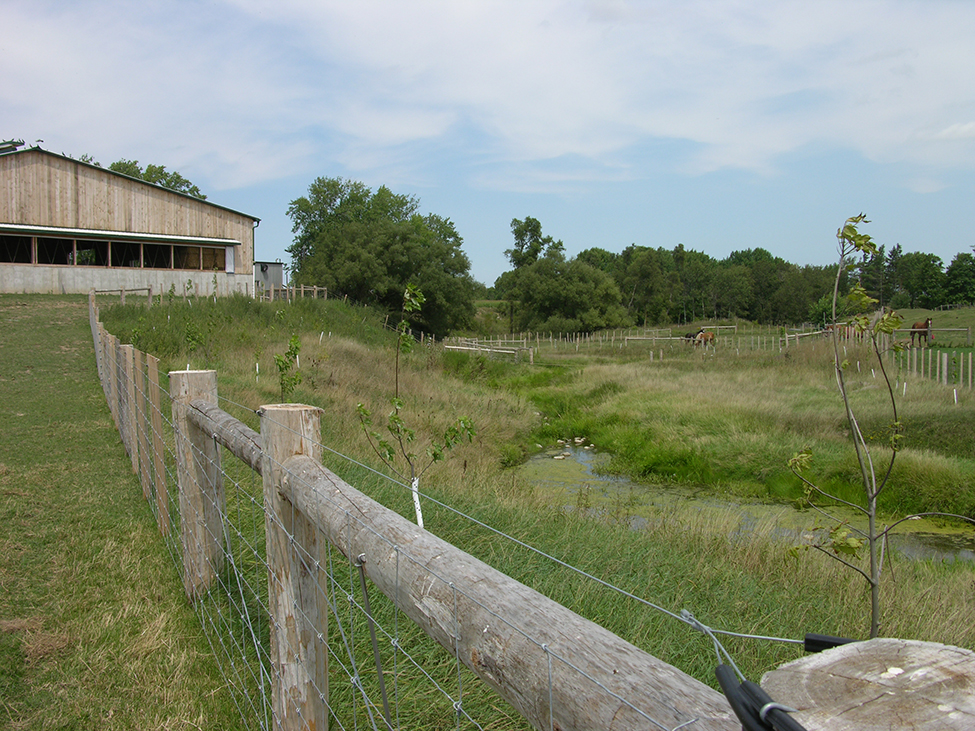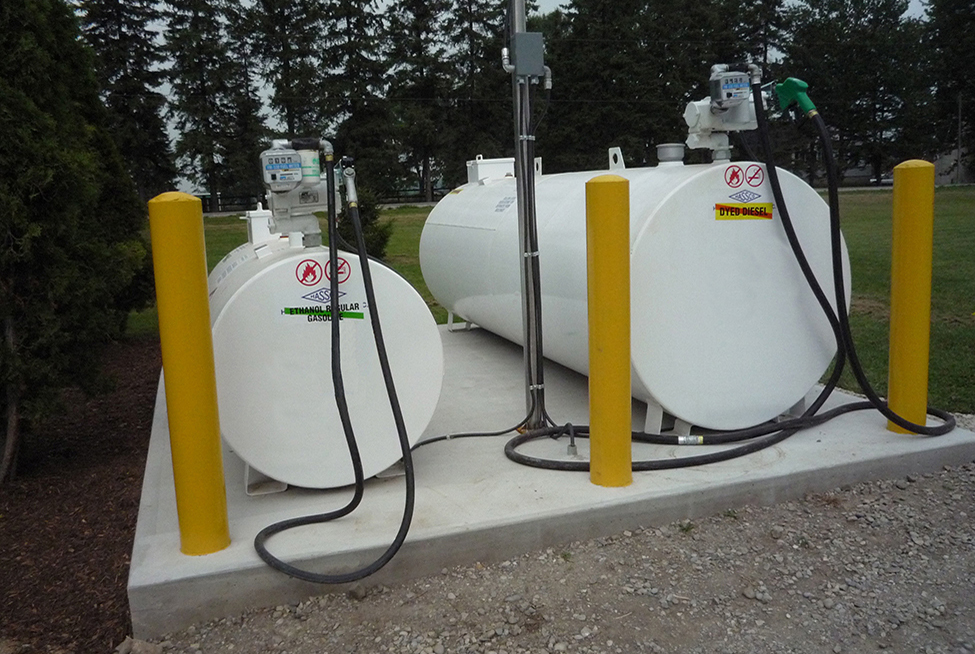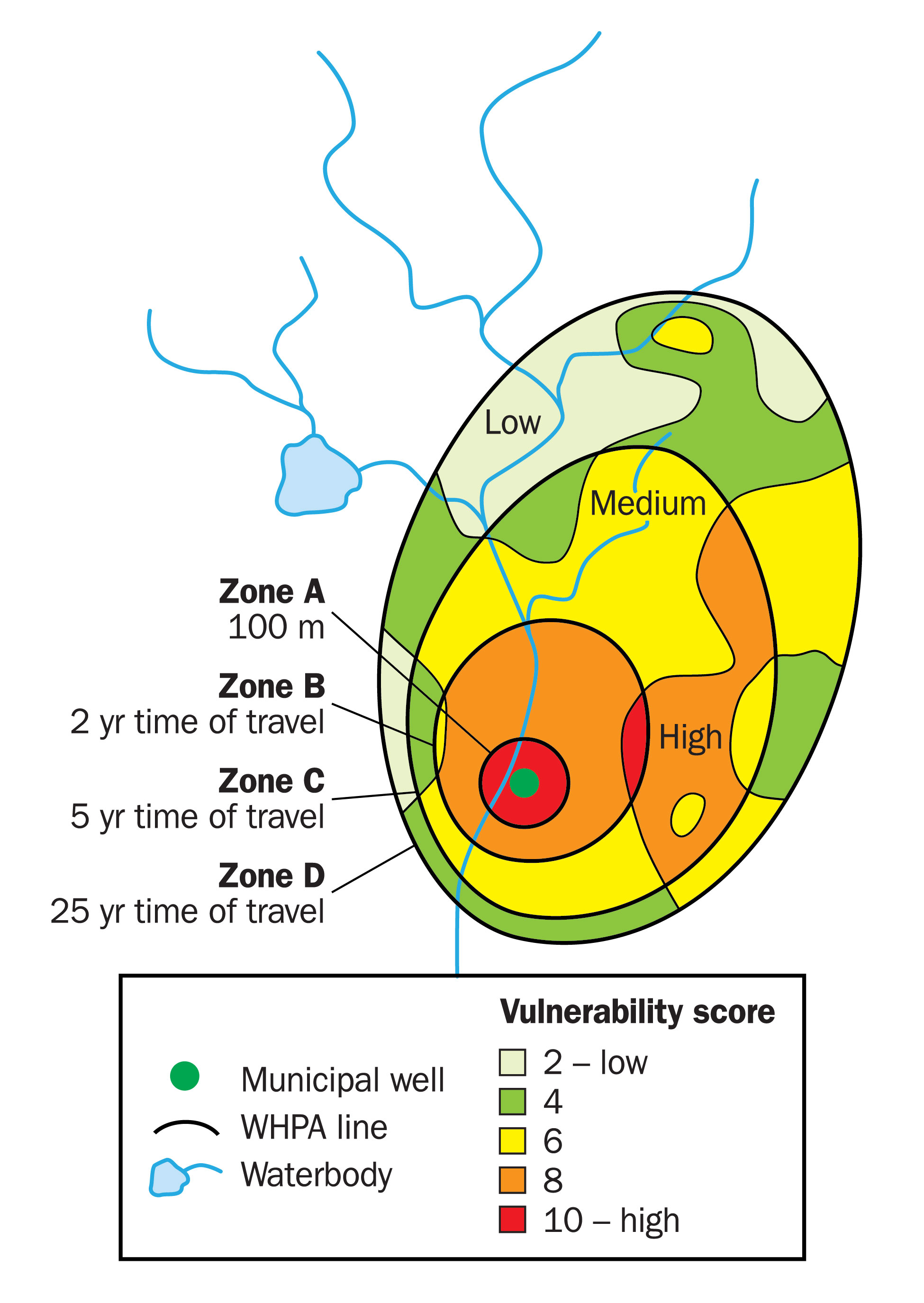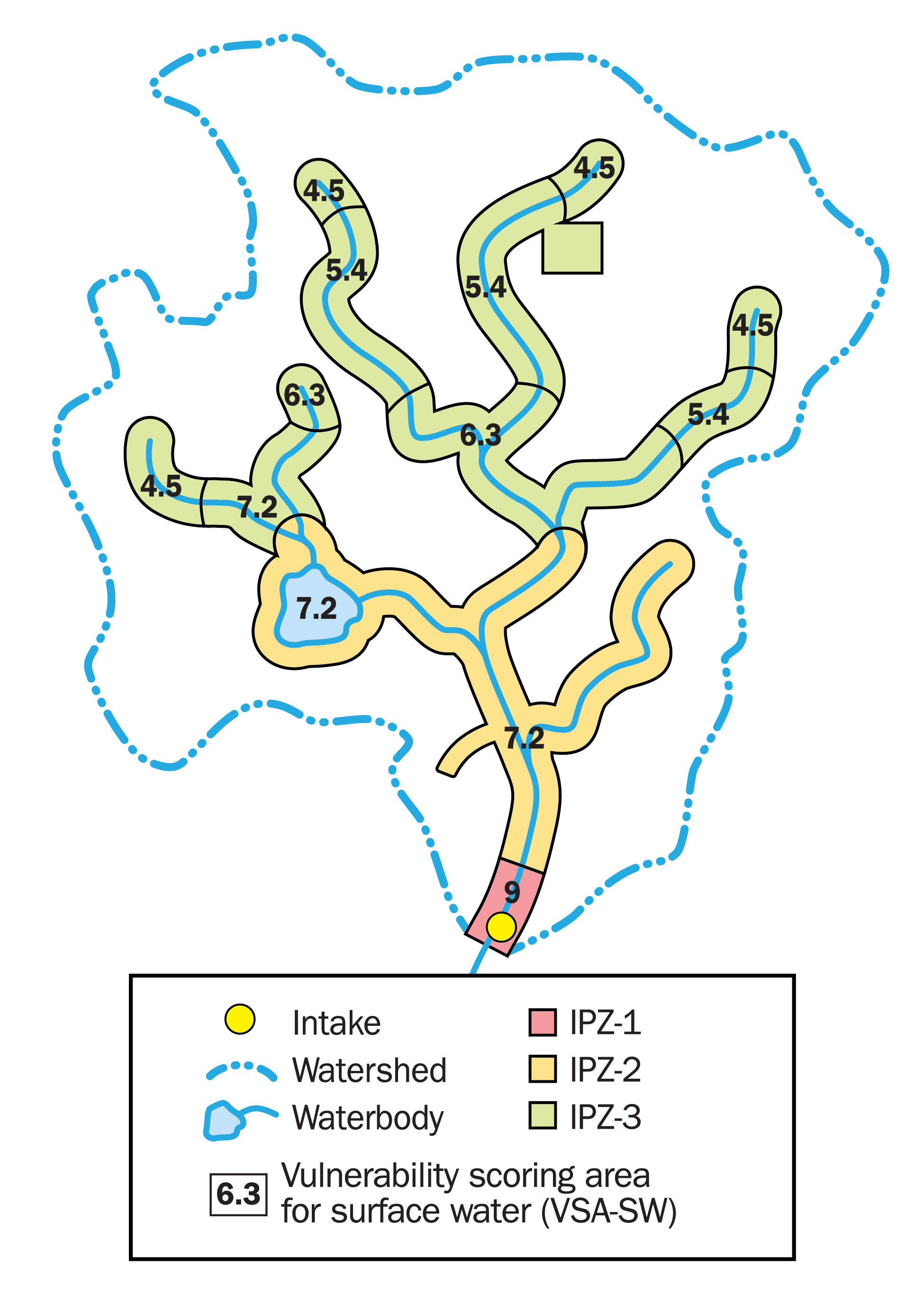Source water protection plans on the farm
Learn about threats to on-farm drinking water, different protection plan policy types and on-farm compliance requirements to protect ground and source water.
ISSN 1198-712X, Published August 2023
Introduction
The protection of drinking water is everyone's responsibility. The activities practised on a farm have the potential to adversely affect groundwater and surface water resources that may be a source of drinking water. Consequently, farmers play a key role in water management on their operations. This fact sheet will assist farmers who are affected by source protection plans (SPPs) by providing an overview of the Clean Water Act, 2006 (CWA) and summarize the ways that a farm can be affected by local SPP policy requirements that protect municipal drinking water resources. Also discussed are the different SPP policy types, on-farm compliance requirements and the resources available. It also examines compliance options for affected farms that are phased-in under the Nutrient Management Act, 2002 (NMA).
It is important to understand local SPP policy requirements for activities on the farm. This includes identifying resources that are available to address any threats to drinking water (Figure 1).

The CWA, administered by the Ministry of the Environment, Conservation and Parks (MECP), provides an approach for protecting existing and future sources of municipal drinking water. Under the authority of the CWA, local source protection committees are using this approach in several ways by:
- identifying areas surrounding municipal groundwater wells and surface water intake zones that are vulnerable to contamination or depletion. These are known as wellhead protection areas (WHPAs), intake protection zones (IPZs) and issue contributing areas (ICAs).
- identifying and classifying activities, including those on farm operations, that could be significant, moderate or low drinking-water threats. They may pose a risk to municipal water sources from a quality or quantity perspective.
- developing SPPs for municipalities across the province. Each plan contains mandatory policies for significant drinking-water threats, as well as other (generally non-binding) policies for moderate and low drinking-water threats.
From a farming perspective, SPP requirements lay the foundation for a process for:
- negotiating risk management plans (RMPs) and the implementation of other risk management measures, for farms where significant threats must be managed
- ensuring that existing and new prescribed instruments under the NMA comply with SPP policy requirements
On-farm drinking water threats
Land-use activities classified as a significant threat to drinking water must be addressed by SPP policies. On-farm activities classified as a significant threat to drinking water include:
- land application, handling and storage of:
- agricultural source material (ASM)
- non-agricultural source material (NASM)
- commercial fertilizer
- selected pesticides
- handling and storage of heating fuel (fuel oils, volumes greater than 2,500 L) (Figure 2)
- handling and storage of motor fuels (liquid fuels, volumes greater than 2,500 L)
- use of land for an outdoor confinement area or livestock yard
- use of land for grazing or pasturing
Septic systems can be considered a significant threat on agricultural properties.

Vulnerable areas
4 types of vulnerable areas are described in the CWA and its regulations.
WHPAs and IPZs are 2 areas where farm activities may be classified as significant threats to drinking water, and where SPP policy requirements may require farm activities to be prohibited or managed.
The other 2 vulnerable areas that may affect land-use activities through future municipal land-use planning decisions are highly vulnerable aquifers (HVAs) and significant groundwater recharge areas (SGRAs). Farm activities in these areas cannot be classified as significant threats. As a result, SPP policies cannot prohibit or require their management. These areas and any SPP policies concerning them are not discussed further in this fact sheet.
Wellhead protection areas (WHPAs)
A WHPA (Figure 3) is an area of land where water pumped by the municipal well is recharged. Parts of a WHPA may be vulnerable to farm activities that could affect the quality and quantity of the groundwater that is the municipal drinking water source. Under the authority of the CWA, farm activities classified as significant threats to drinking water within a WHPA must be regulated or managed.

Each WHPA is divided into zones (WHPA-A, WHPA-B), each one progressively farther from the wellhead. Farm activities can be affected by SPP policies in WHPA-A, WHPA-B, WHPA-E and WHPA-F zones.
WHPA-E and F zones (not shown) are delineated where there is surface water interaction with groundwater. A WHPA-Q can also be delineated where the quantity of groundwater that supplies a municipal well is under stress due to water taking. More information about wellhead protection areas is available from your local conservation authority or Conservation Ontario.
Intake protection zones (IPZs)
An IPZ (Figure 4) is an area of water and land that provides water for a municipal surface water intake and is vulnerable to land-use activities that could contaminate or deplete the river, stream or lake that is the source for municipal drinking water. Under the authority of the CWA, significant drinking water threats within an IPZ must be regulated or managed.

Each IPZ is divided into zones (IPZ-1, IPZ-2), each one progressively farther from the intake. Farm activities can be affected by SPP policies in Zone 1, Zone 2 and Zone 3.
An IPZ-Q can be included where the quantity of surface water that supplies a municipal intake is under stress due to water taking. More information about intake protection zones is available from your local conservation authority or Conservation Ontario.
Issue Contributing Areas (ICAs)
A water-quality issue, as identified by a local source protection committee, is where a contaminant is present at a level of concern or showing an upward trend, and threatens the municipal drinking water source. The ICA is an area of land or water where activities are contributing to the water-quality issue. The location of the ICA is defined in the SPP, and any activities located within the ICA that may be contributing to the issue are classified as a significant threat to drinking water.
For example, if nitrate is determined to be affecting the quality of the drinking water, the area from which the nitrate originates is defined as the ICA. ICAs are only identified within vulnerable areas, and any significant threats within them must be regulated or managed.
Source protection plans
SPPs have been approved by the MECP and are being implemented. Farmers whose existing activities are affected by SPP policies should have been contacted by the local source protection committee and/or conservation authority during the preparation of the SPP. If you have not been contacted, or if you are uncertain if you are affected by SPP policies, contact your local conservation authority or Conservation Ontario.
Some agricultural activities may be affected by SPP policies. The SPP typically includes information that:
- outlines the approaches used to manage risks associated with significant drinking-water threats
- explains what a RMP is and what resources are available to help prepare for negotiating RMPs
- describes how to meet the requirements of an SPP policy for an activity that is already regulated through the NMA, such as a NASM plan, a nutrient management plan (NMP) or a nutrient management strategy (NMS)
The SPP process should not affect the farming activities of those farmers who have already implemented practices that will meet local SPP policy requirements.
Risk management approaches
An SPP policy has a range of approaches for mitigating the risks to municipal drinking water sources. These include:
- prohibiting an existing activity
- prohibiting a future activity
- managing the risks associated with an existing or future activity
- education and outreach, or other non-regulatory approaches
An SPP may also contain policies concerning moderate or low threats to drinking water and affected public bodies, such as a municipality. Farm activities should not be directly affected by policies for moderate or low threats. Under these circumstances, municipalities may be required to develop education and outreach programs to help landowners become more aware of better ways to manage and protect groundwater and surface water resources. Additional information about how activities are classified as significant, moderate or low threats, and the risk management approaches selected, is available from your local conservation authority.
Prohibition
Under the CWA, an SPP can prohibit a farming activity located in a WHPA or IPZ if the activity has been classified as a significant threat. There are limited options available for farmers when an SPP policy prohibits an existing or future activity: farmers must comply. The local municipality may also be required to revise its planning tools (Official Plan or bylaws) to be consistent with an SPP policy or revise them on its own to protect groundwater or surface water resources.
Existing activities are prohibited in situations where a source protection committee concludes that no other approach is sufficient to protect the water source. source protection committees are required to consider all possible approaches before prohibiting any existing activity. Additional information concerning why an existing activity was prohibited is available from the local conservation authority.
Risk management plans
Farmers whose activities are classified as significant threats to drinking water may be required to put into place a site-specific RMP. The RMP summarizes the actions a farmer will take to manage the risks associated with an activity that is a significant threat to drinking water. An RMP is not required for moderate or low threats.
An RMP is a legally binding document that summarizes an agreement between a farmer and a local risk management official (RMO). RMOs are employed by the municipality that is responsible for implementing local SPP policies or employed by another organization to which the municipality has delegated its authority (such as a conservation authority). An RMO or a risk management inspector (RMI) has authority under the CWA to visit affected farms as part of the RMP process where a farm activity has been identified as a significant threat. RMOs have authority to negotiate and enforce the requirements of RMPs within their municipalities.
In most cases, the RMP can be negotiated between the local RMO and the farmer. If negotiations fail, the RMO has the authority by order to establish an RMP for the farm activity that has been classified as a significant threat to drinking water. Where an RMP has been established by an RMO (by order), the farmer has the right to request a hearing with the Ontario Land Tribunal (OLT) to appeal the order.
Where a source protection committee has decided that a farm activity should be managed using an RMP, it is important to note that an RMO cannot require a condition in an RMP that would effectively prohibit or stop an activity outright. The role of the RMO is to implement SPP policies developed by the source protection committee and approved by the MECP. The intent is to include conditions that manage any risks associated with an activity that is a significant threat to drinking water. However, where using an RMP to manage a farm activity is required, a farmer could decide not to engage in activities that have been classified as a significant threat.
Because RMOs are local employees of the municipality or conservation authority, the format of an RMP and the process for negotiating it vary across Ontario. Further information about the risk management planning approach is available from the local RMO.
Farm source water protection plan
A Farm source water protection plan framework and workbook helps farmers work through the RMP process. The workbook includes a series of worksheets for creating an inventory of existing activities and assigns a risk reduction rating for any activity that is classified as a significant drinking water threat. This includes worksheets for wellhead protection area zones and surface water intake protection zones. When creating an inventory and assigning risk reduction ratings, you may find that you already manage any identified significant threats to drinking water adequately. Confirm this during the negotiation of the RMP with the RMO.
The framework worksheets are based on principles used in the Environmental Farm Plan (EFP). Some information needed to complete the farm source water protection plan workbook can be transferred from your completed EFP workbook. The EFP contains applicable legal standards or agri-environmental benchmarks that have been developed using agricultural and environmental science and technical experience.
Prescribed instruments
An SPP may contain policies that require actions be taken to ensure that agricultural activities (even those already regulated under the NMA) are not, or do not become, significant drinking-water threats. Instruments issued under the NMA (both those that are approved by the Ministry of Agriculture, Food and Rural Affairs (OMAFRA) and those that are not) are designated prescribed instruments under the CWA and may be used to implement SPP policies.
The following are prescribed NMA instruments under the CWA:
- NMS
- NMP
- NASM plan
Where these policies exist, OMAFRA will contact farmers who have an approved instrument (a NASM plan or NMS) to let them know that their instrument must be reviewed. Approved instruments must be updated by a certified person to account for SPP policies and submitted to OMAFRA for review. OMAFRA will ensure the prescribed instruments comply with SPP policies. If necessary, OMAFRA will also apply any additional conditions needed as part of the SPP review.
For prescribed instruments that are not approved by OMAFRA (NMPs and some NASM plans or NMSs) the director does not have the authority to ensure the prescribed instrument conforms with the applicable SPP policies. The farmer should work with the certified preparer to incorporate any changes necessary to ensure the instrument complies with the applicable SPP policies. It is anticipated that in most cases there will be minor, if any, changes to an instrument that is compliant with the NMA. However, if the activity is classified as a significant threat to drinking water, the instrument may require additional measures. The local RMO is also a resource that can be used to help ensure conformity of the prescribed instrument.
Phased-in farms and RMPs
In some situations, an SPP policy may require that an RMP be prepared for an agricultural activity that may already be regulated under the NMA and has an instrument. In this case, a farm operation may be exempt from the requirement for an RMP (Section 61 of Regulation 287/07), and a farmer can choose to have the activity addressed through the prescribed NMA instrument.
There are several steps that must be taken to gain this exemption:
- Notify the local RMO that the activity is already subject to an NMA instrument. Provide a copy of the instrument or provide an indication of how you intend to obtain the instrument for the activity. The RMO will provide a date when a copy of the instrument is to be submitted.
- The instrument must either contain or accompany a statement of conformity that states the instrument complies with the requirements of the SPP policies concerning the significant threat. If the instrument does not contain this statement of conformity, get a statement from the person or body that created the instrument, indicating that it conforms to the requirements of the SPP policies.
- If the instrument was approved by OMAFRA and is still active, this statement can be requested from the ministry. If the instrument is not approved by OMAFRA, the statement must be requested from the certified preparer.
It is important to note that the RMO has no authority under the CWA to require specific conditions be added to a prescribed instrument. Nor does the RMO have authority to determine whether a prescribed instrument conforms to the significant drinking water threat policy - this is the role of the instrument creator or issuer, or OMAFRA where the ministry has approved the instrument. Farmers may voluntarily choose to implement additional actions on the farm, but the RMO cannot require this where the activity is subject to a prescribed instrument or where a statement of conformity has been provided. However, the ministry will work closely with RMOs during the review of affected instruments that are approved by OMAFRA. Where the instrument is not approved by OMAFRA, the ministry encourages farmers and certified preparers to work with RMOs.
There may be parts of a farm operation that are not subject to an NMA instrument and therefore cannot be exempted from the requirements of an RMP. For example, the land application of agricultural source material on a farm operation may be subject to an NMA instrument, but the land application of pesticides is not. Although pesticide use may be regulated under the Pesticides Act, 1990, in these situations, it is necessary to negotiate an RMP with the RMO to ensure that activities comply with local SPP policies.
Land-use planning
SPPs contain land-use planning policies concerning significant, moderate and low threats. Land-use planning tools under the Planning Act, 1990 (such as official plan policies and zoning bylaws), are used by municipalities to permit or restrict certain future land-use categories. Note that these planning tools cannot be used to limit individual activities on the farm, such as the land application of agricultural source material.
Official plans and zoning bylaws must be revised to comply with SPP policies for significant threats and they must consider SPP policies regarding moderate and low threats. Land-use policies usually apply to future land uses and should not affect existing activities on the farm.
Further information about source protection plan policies
SPP policies were developed by source protection committees composed of representatives from the local community. Local conservation authorities can provide information about:
- the purpose and rationale for SPP policies
- the underlying science and decision-making process by which agricultural activities were classified as significant, moderate and low threats to drinking water
- the rationale for the risk management approaches used when developing SPP policies
Request for a hearing
In specific instances, the CWA allows a farmer to request a hearing before the OLT. This includes situations where the RMO (or RMI, where applicable) has issued an order for an RMP under the CWA. If a hearing is requested, the OLT will decide if the order should be upheld. Farmers who object to something specific in an RMP may request that the RMP be amended. If the RMO or RMI refuses to amend the plan, the farmer can request a hearing based on that refusal.
For more information on how appeal decisions are made, visit the OLT website.
Summary
Understanding and getting prepared to comply with the local SPP policy requirement includes determining which activities are classified as significant drinking-water threats, where these threats are located and how they will be regulated under the CWA. Contact local conservation authorities for information on the SPP policies in your area.
Disclaimer
The information in this factsheet is provided for informational purposes only and should not be relied upon to determine legal obligations. To determine your legal obligations, consult the relevant law. If legal advice is required, consult a lawyer. In the event of a conflict between the information in this factsheet and any applicable law, the law prevails.
This fact sheet was reviewed by Brittany Barkes, and originally written by Hugh Simpson, program analyst, OMAFRA, Brittany Barkes, environmental specialist, OMAFRA, Matt Wilson, nutrient management program team lead, OMAFRA and Len Senyshyn, approvals, certification and licensing, OMAFRA.